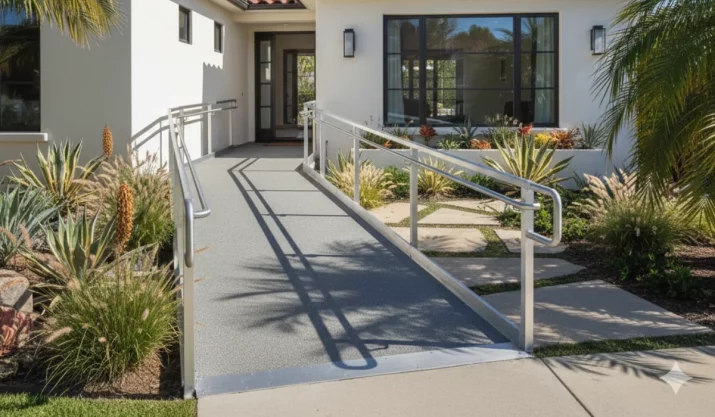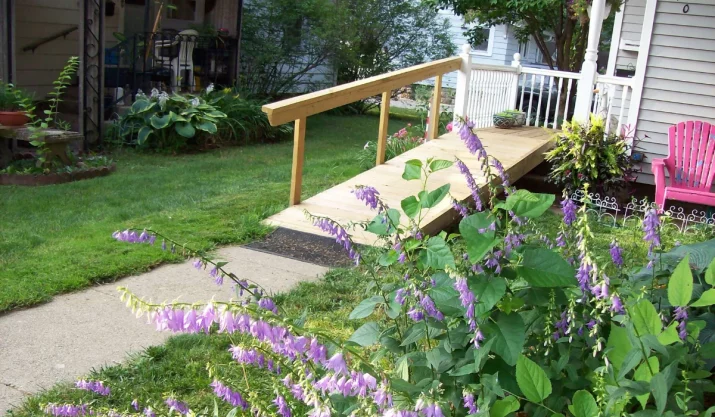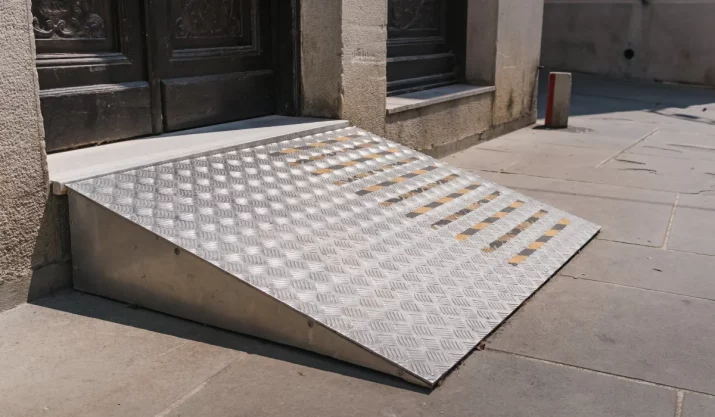How to Prepare for Wheelchair Ramp Installation in San Diego

Table of Contents
- Key Takeaways:
- Understanding ADA Requirements for Wheelchair Ramps
- Measuring Your Space and Planning Your Ramp
- Choosing the Right Type of Wheelchair Ramp
- Preparing Your Property for Installation
- Working With a Professional Installer in San Diego
- Making the Right Wheelchair Ramp Choice for Your San Diego Home
- FAQs
If you or a loved one uses a wheelchair, scooter, or power chair, safe home entry matters every day. A well-built ramp gives you smooth, secure access to your home. Knowing how to prepare for wheelchair ramp installation in San Diego helps you plan, follow local rules, and make your ramp safe and comfortable to use.
Many San Diego homes have sloped driveways, raised entries, or curbs that complicate access. With a few simple steps, your ramp install can go smoothly. Think about ramp length, safe surfaces, and ADA-compliant features that fit your home and mobility needs.
This guide covers what to do before installation day and how to measure your space, pick the right ramp type, and get ready to work with a professional.
Key Takeaways:
- Measure your entry height to find the correct ramp slope and ramp length.
- Follow ADA and San Diego building codes for a safe, legal ramp.
- Choose strong, non-slip materials and include handrails for extra safety.
- Schedule a home consultation and free quote with a licensed local installer.
Understanding ADA Requirements for Wheelchair Ramps
Before you install a ramp, know what makes it safe and ADA-compliant. The Americans with Disabilities Act (ADA) sets clear ramp rules so ramps are safe for wheelchair users, caregivers, and anyone using mobility devices.
The ADA slope rule is simple: for every 1 inch of rise, you need 12 inches of ramp length. If your entry is 24 inches high, your ramp should be at least 24 feet long. This gentle slope makes it easier and safer for manual wheelchairs and power chairs.
Ramps should also have:
- Handrails on both sides for support.
- A slip-resistant surface to prevent accidents.
- Edge protection to prevent wheels from sliding off.
- Flat landings at the top and bottom, at least 5 feet long, for turning and resting.
In California, local building codes support ADA requirements, which may include additional safety measures. San Diego requires most permanent ramps to have permits. A professional installer who knows the local rules can handle the paperwork for you.
At California Mobility, we offer a selection of wheelchair ramps and installation services across San Diego and nearby areas. Our licensed team handles measuring, ADA-compliant design, permits, and installation. We make sure every ramp is safe, sturdy, and approved before you use it.
Measuring Your Space and Planning Your Ramp
Accurate measurements are the first step to a safe wheelchair ramp installation. Start by measuring the height from the ground to your doorway.
Is your home ready for a wheelchair ramp? That number tells you how much ramp length you need using the ADA’s 1:12 rule, which is part of the ADA Wheelchair Ramp Rules for Homes in California.
For example, a 30-inch rise needs about 30 feet of ramp. Include landings at the top and bottom, at least 5 feet wide, for turning or resting.
When planning, think about:
- Ramp slope: A gentle slope is safer and easier for manual wheelchair users.
- Width: At least 36 inches wide, or wider if you use a scooter or power wheelchair.
- Surface type: Choose non-slip or slip-resistant materials, especially for outdoor ramps.
- Handrails and grab bars: Great for balance and caregiver support.
If your yard is small or uneven, you can set up a modular wheelchair ramp in sections to fit tight spaces. For short rises, threshold ramps work well at doorways. For long-term needs, a permanent ramp may be the best choice.
Choosing the Right Type of Wheelchair Ramp
Different homes need different types of wheelchair ramps. The right choice depends on your property, your mobility needs, and your long-term plans. Many homeowners consider whether a portable or permanent wheelchair ramp best fits their situation.
1. Portable Wheelchair Ramps: Portable ramps are lightweight and easy to move. They’re great for renters or anyone who travels often.
2. Modular Wheelchair Ramps: Manufacturers build these ramps from aluminum sections that can be added or removed. They’re ideal for homes with uneven ground or driveways.
3. Permanent Ramps: If you plan to stay in your home long-term, a permanent ramp made from concrete or treated wood is a cost-effective option. You can build this type of ramp to match your home and add long-lasting value.
4. Aluminum Wheelchair Ramps: Aluminum wheelchair ramps are popular in San Diego because they don’t rust and are easy to maintain. They stay non-slip even in coastal fog or rain, making them perfect for local weather.
Whatever you choose, include handrails, edge protection, and other safety features. Working with an installer helps make sure your ramp meets ADA rules and local codes.
At California Mobility, we install high-quality aluminum, modular, and permanent ramps backed by a full warranty for long-term reliability.
Preparing Your Property for Installation
Do a few simple tasks to get your property ready for ramp installation. Clear the ramp area by moving furniture, plants, and décor out of the way. For outdoor ramps, the ground should be flat and firm.
If the yard is uneven, your installer may pour a small concrete pad or level the soil to create a firm base that won’t shift after heavy rain.
If curbs or parking spots are nearby, plan how the ramp will align with the driveway or walkway. For indoor ramps, make sure doors open fully and consider adding grab bars near entrances.
The CDC notes that fall prevention starts with good home access, including secure ramps, stable floors, and safe entryways. Older San Diego homes, such as those in Hillcrest or Kensington, may need minor changes, such as widening a doorway or adjusting a landing.
At California Mobility, we manage installation from prep to final checks to make sure your ramp is safe and ready to use.
Working With a Professional Installer in San Diego
While some people try to build their own ramps, hiring a licensed professional is safer and more reliable. A pro understands local building codes, ADA requirements, and how to design for San Diego’s hills, slopes, and weather.
At California Mobility, every ramp install starts with a home consultation. We review your entry, weight needs, and the best layout for your device, whether a manual chair, scooter, or power chair.
We help you choose materials and design a ramp that fits your space and budget. Since San Diego usually requires permits for permanent ramps, we handle the paperwork.
Our installs include a full warranty, and we also offer stair lifts, wheelchair lifts, and grab bars to make your home even safer.
Making the Right Wheelchair Ramp Choice for Your San Diego Home
A wheelchair ramp can significantly improve daily life by making every entrance safer and more comfortable. It gives you easier access to your home and helps you stay independent longer.
At California Mobility, we provide trusted wheelchair ramp installation across San Diego, offering durable, ADA-compliant designs that fit your space and lifestyle. Our team focuses on long-lasting quality and safe, smooth use for every customer.
Want to get started? Contact us today or request a free quote to find the proper accessibility solution for your home.






